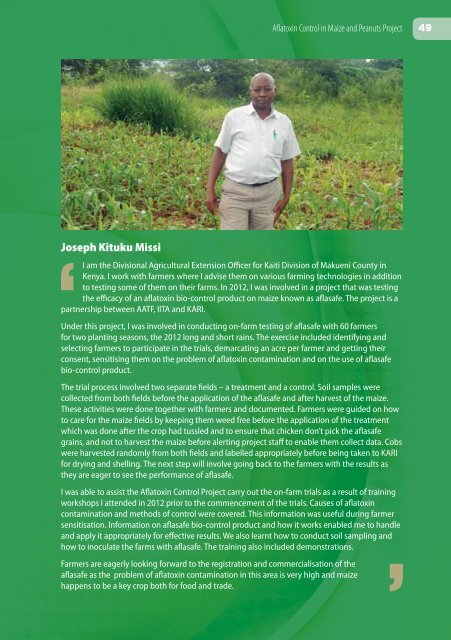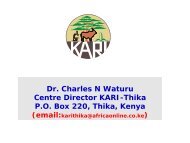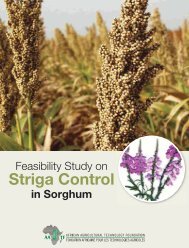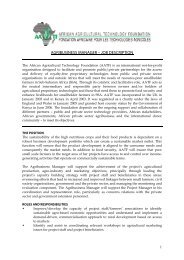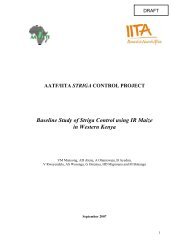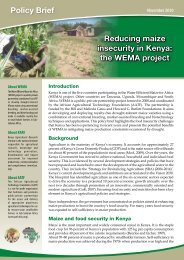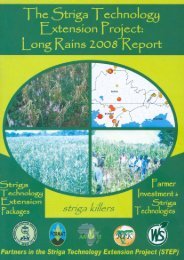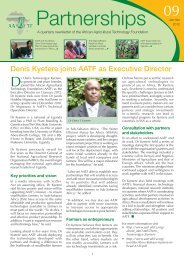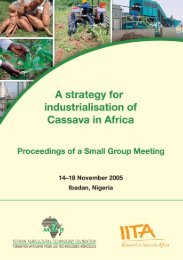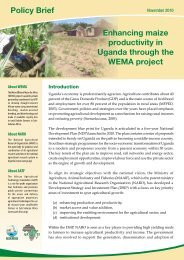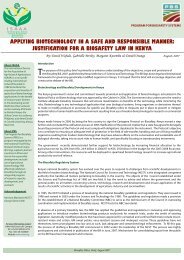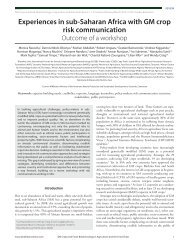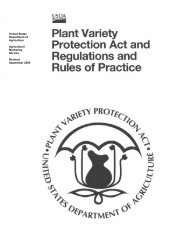Annual Report 2012 - African Agricultural Technology Foundation
Annual Report 2012 - African Agricultural Technology Foundation
Annual Report 2012 - African Agricultural Technology Foundation
You also want an ePaper? Increase the reach of your titles
YUMPU automatically turns print PDFs into web optimized ePapers that Google loves.
Aflatoxin Control in Maize and Peanuts Project 49<br />
Joseph Kituku Missi<br />
I am the Divisional <strong>Agricultural</strong> Extension Officer for Kaiti Division of Makueni County in<br />
Kenya. I work with farmers where I advise them on various farming technologies in addition<br />
to testing some of them on their farms. In <strong>2012</strong>, I was involved in a project that was testing<br />
the efficacy of an aflatoxin bio-control product on maize known as aflasafe. The project is a<br />
partnership between AATF, IITA and KARI.<br />
Under this project, I was involved in conducting on-farm testing of aflasafe with 60 farmers<br />
for two planting seasons, the <strong>2012</strong> long and short rains. The exercise included identifying and<br />
selecting farmers to participate in the trials, demarcating an acre per farmer and getting their<br />
consent, sensitising them on the problem of aflatoxin contamination and on the use of aflasafe<br />
bio-control product.<br />
The trial process involved two separate fields – a treatment and a control. Soil samples were<br />
collected from both fields before the application of the aflasafe and after harvest of the maize.<br />
These activities were done together with farmers and documented. Farmers were guided on how<br />
to care for the maize fields by keeping them weed free before the application of the treatment<br />
which was done after the crop had tussled and to ensure that chicken don’t pick the aflasafe<br />
grains, and not to harvest the maize before alerting project staff to enable them collect data. Cobs<br />
were harvested randomly from both fields and labelled appropriately before being taken to KARI<br />
for drying and shelling. The next step will involve going back to the farmers with the results as<br />
they are eager to see the performance of aflasafe.<br />
I was able to assist the Aflatoxin Control Project carry out the on-farm trials as a result of training<br />
workshops I attended in <strong>2012</strong> prior to the commencement of the trials. Causes of aflatoxin<br />
contamination and methods of control were covered. This information was useful during farmer<br />
sensitisation. Information on aflasafe bio-control product and how it works enabled me to handle<br />
and apply it appropriately for effective results. We also learnt how to conduct soil sampling and<br />
how to inoculate the farms with aflasafe. The training also included demonstrations.<br />
Farmers are eagerly looking forward to the registration and commercialisation of the<br />
aflasafe as the problem of aflatoxin contamination in this area is very high and maize<br />
happens to be a key crop both for food and trade.<br />
Deploying agricultural technologies for farmers


